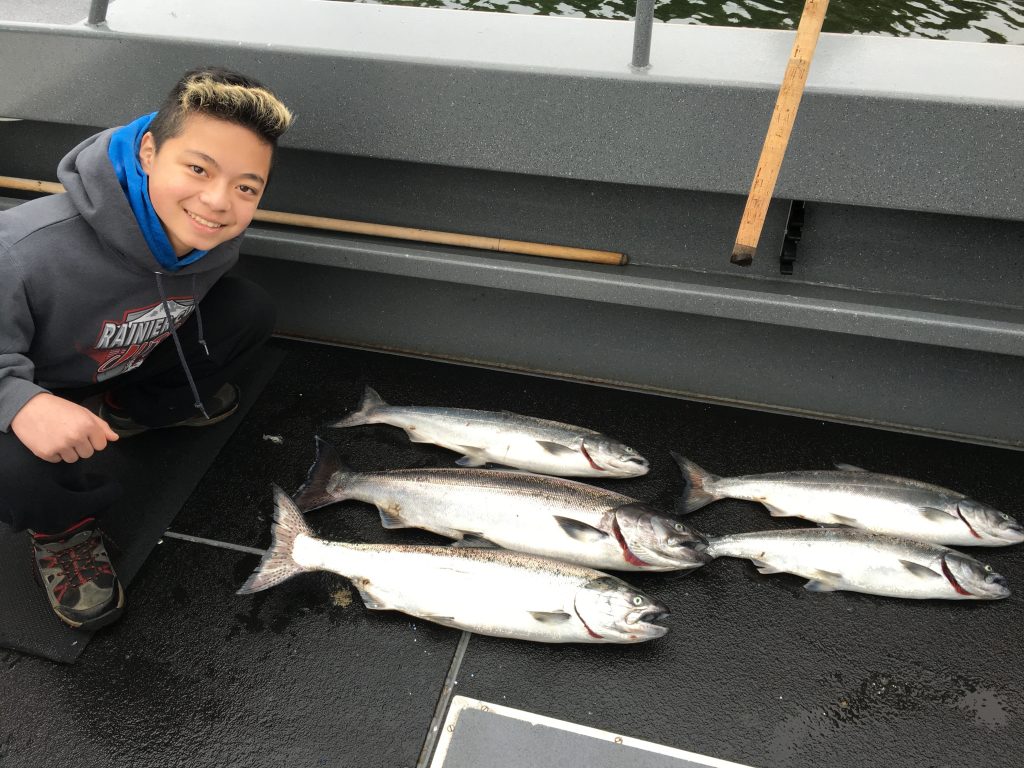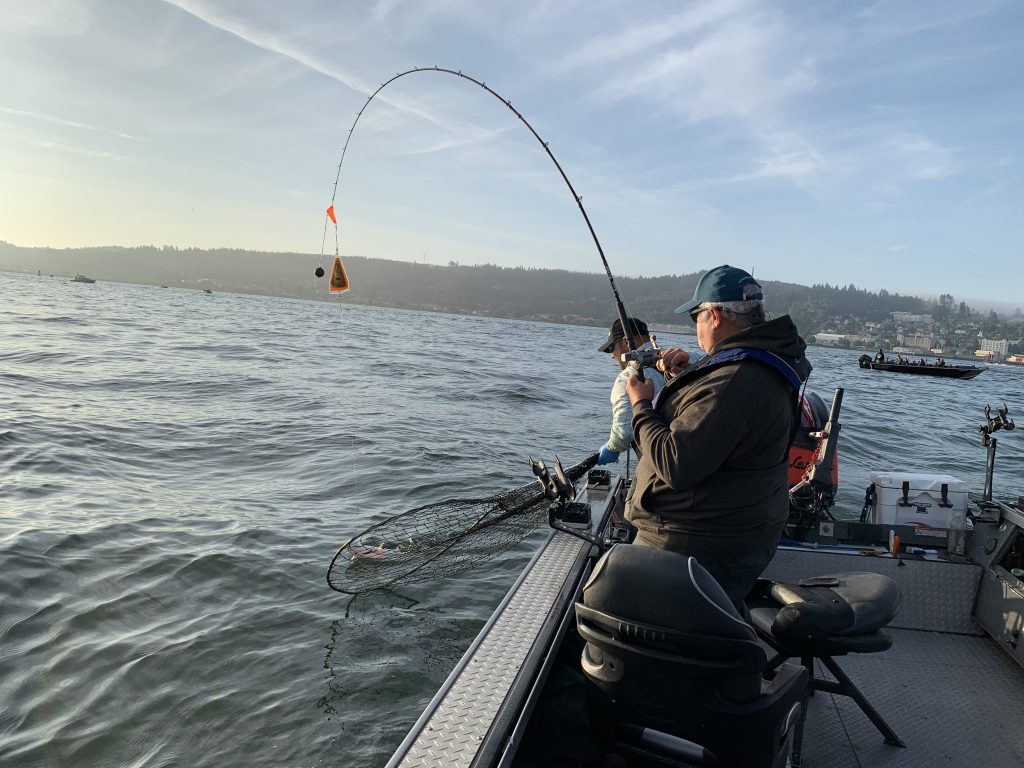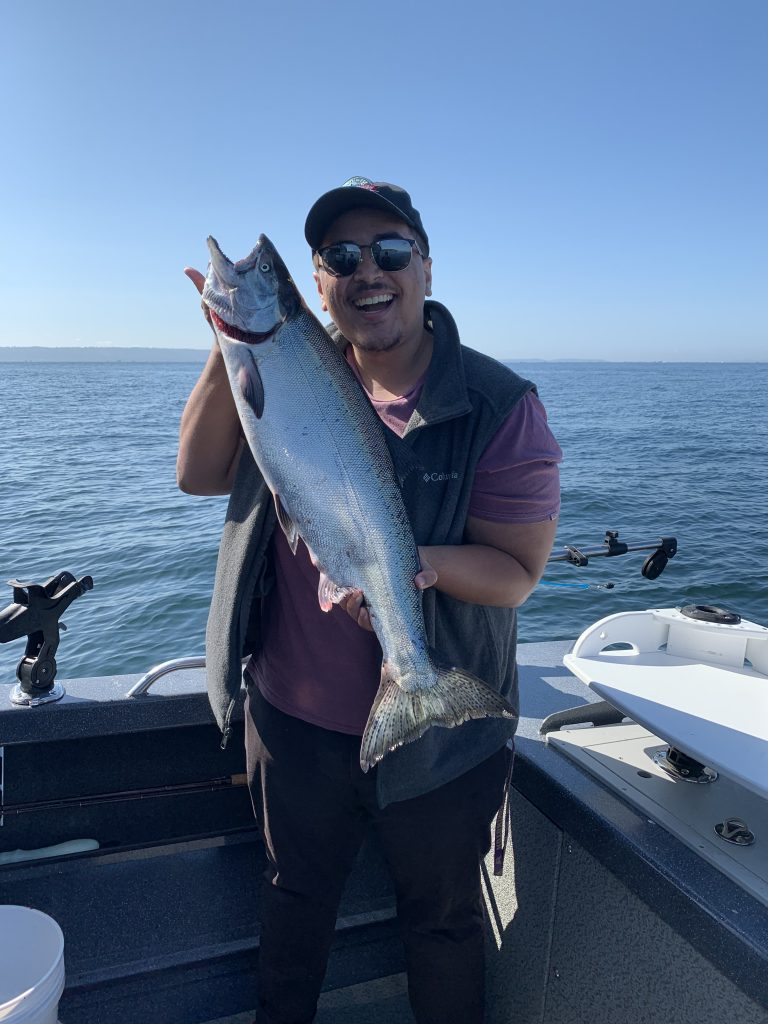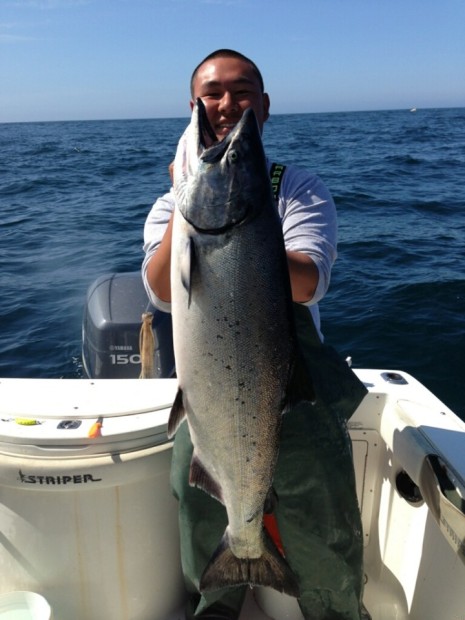Historic closure of winter chinook fisheries in many areas of Puget Sound are part of the 2020-2021 salmon season package Leave a reply

Dear winter blackmouth:
It was a great relationship we had for so many decades but it’s time to move on. It wasn’t an easy choice nor an easy pill to swallow for the majority of anglers who enjoyed spending time with you on the water. To say the least this decision to cut you out of their life was “complicated.”
When you walked out of the salmon season setting process door on Friday (April 10), it hurt deeply and thoughts of the “good old days” came flooding back filled with joy, sorrow, success and defeat.
As with any fall out the finger of blame for this break up could point to a myriad of issues like declining populations of Stillaguamish, Skagit and mid-Hood Canal chinook just to name a few salmon stocks of concern.
Even more upsetting is our polluted watersheds leading to a steep drop of robust habitat; seals and sea lions and other predators feasting on chinook at an alarming rate; issues associated with southern resident killer whales; and negative environmental factors such as droughts, flooding and the dreaded the “Blob” –a large mass of warm water in the Pacific Ocean that killed off large numbers of cold-water sea creatures.
To make matters worse, anglers never got a chance to say farewell due to the current statewide fishing ban tied to the COVID-19 pandemic, which eventually led to a premature closure of marine salmon fishing in Puget Sound.
Now all that’s left are thoughts of your shimmering silvery and purplish colors; that wonderful smell of “chinookie” in the chilly morning air (thanks for the quote from my fishing friend Tony Floor); and most of all what a great sport you were to the 15,000 to 22,000 anglers who turned out every winter.
Even in the darkest, bleakest days you shined brightly and warmed the hearts of thousands who eagerly awaited a chance to hook up with you at their favorite fishing holes.
This fond relationship came to an end during the annual salmon season setting process on Friday (April 10) at the Pacific Fishery Management Council and joint state, tribal and federal fishery managers teleconference and webinar meetings where all fisheries were decided.
It was by no means an easy job for the Washington Department of Fish and Wildlife (WDFW), and a tough pill to swallow for sport-fishing constituents as well as many others who worked tirelessly and made gut-wrenching choices.
“It was a tough year and no one is going to have a good fishing season,” said Kelly Susewind, the WDFW Director. “We had a much smaller pie and everyone wanted a bigger slice.”

A few chunks of waterway unaffected by the winter closure are the western Strait at Sekiu (5) from open March 1 to April 30; central Puget Sound (10) open Jan. 1 to March 31; and southern Puget Sound (13) open year-round.
Saying goodbye to something you cherish is never easy and all anglers can do is hope to one day meet again. Yes, hope is eternal and everyone needs to ensure themselves the “break up” could soon turn into a quick “make up” in the not too distant future.
Other salmon fishing options
In central Puget Sound (10), the highly popular resident coho only season opens June 1 to July 15. Then hatchery-marked chinook is fair game from July 16 to Aug. 31 with a catch quota of about 4,149. Fishing stays open Sept. 1 to Nov. 16 for coho and then anglers can add chum beginning on Sept. 16. There will also be a small window of opportunity in inner-Elliott Bay from Aug. 2 to noon on Aug. 5.

South-central Puget Sound (11) should see a rather robust summer hatchery king fishery from July 1 to Sept. 30 with a quota of 4,182 up somewhat from 2019. There will also be a season Oct. 1-31 directed at CNR coho. Southern Puget Sound (13) is open year-round for salmon.
In the Strait of Juan de Fuca at Sekiu (5) fishing for hatchery kings is open July 1 to Aug. 15 (guideline is 3,974 hatchery chinook), and then for hatchery coho from Aug. 16 to Sept. 30.
The eastern Strait (6) will be open for hatchery chinook from July 1 to Aug. 15 (release all chinook east of Ediz Hook) and a guideline of 4,768 hatchery chinook, and then for hatchery coho only from Aug. 16 to Sept. 30.
Hood Canal south of Ayock Point (12) opens July 1 to Sept. 30 for hatchery chinook and a minimum size limit of 20 inches. The entire canal opens Oct. 1 to Nov. 30 for coho and chum may be retained beginning Oct. 16.
There will also be a variety of bubble and terminal fisheries in many areas as well as piers open year-round for shore-bound anglers. The Tulalip Bubble Fishery (8-2) is open for chinook from June 1 to Sept. 2 (fishing allowed Fridays to noon on Mondays only) and Sept. 7-30 (fishing allowed weekends only).
The Puget Sound summer/fall chinook forecast is 256,821 (38,516 are wild) in 2020, slightly up from 246,837 (29,796) and 255,219 (27,404) in 2018.
The Puget Sound total coho return is also down with a forecast of 523,498 (157,214 are wild) compared to 708,521 (293,980) in 2019 and 557,149 (249,174) in 2018.
Coastal salmon opportunities
The total coastal catch quota for sport and non-tribal fisheries is 26,500 hatchery-marked coho (159,600 in 2019) and 26,360 chinook (26,250 in 2019).
At Neah Bay (Area 4) the sport quota is 2,760 hatchery-marked coho and 5,600 chinook. A chinook only fishery will be open daily from June 20-28, and then open daily from June 29 to Sept. 30 or until the subarea catch guideline is achieved.

At La Push (3) the sport quota is 690 hatchery-marked coho and 1,300 chinook. A chinook only fishery will be open daily from June 20-28, and then open daily from June 29 to Sept. 30 or until the subarea catch guideline is achieved.
At Westport (2) the sport quota is 9,800 hatchery-marked coho and 12,460 chinook. A chinook only fishery will be open daily from June 20-28, and then open Sundays to Thursdays only from June 29 through Sept. 30 or until the subarea catch guideline is achieved.
At Ilwaco (1) the sport quota is 13,250 hatchery-marked coho and 7,000 chinook. A chinook only fishery will be open daily from June 20-28, and then open daily from June 29 to Sept. 30 or until the subarea catch guideline is achieved.
The Buoy 10 fishery at the Columbia River mouth will open Aug. 16-27 for chinook and hatchery coho and starting Aug. 28 for hatchery coho only. Catch quota is 16,280 hatchery coho during August and September.
In all, 430,000 fall chinook are expected to return to the Big-C in 2020 compared to a forecast of 340,400 and an actual return of 375,700 in 2019 and 365,600 and 290,900 in 2018.
The meat and potatoes are the upriver bright chinook of 233,400 (158,400 and 212,200 in 2019 and 200,100 and 149,000 in 2018). The lower river “tule” hatchery chinook (a driver for ocean salmon fisheries) is predicted at 51,000 (down from a forecast 54,500 but up from actual return of 48,900 in 2019 and 62,400 and 50,400 in 2018).
On the Washington coast, the Willapa Bay 2020 chinook forecast is up with 31,185 compared to 28,100 in 2019 and down from 44,100 in 2018.
Off the Washington-Oregon coast, a coho forecast of 268,700 is expected in 2020, compared to a preseason forecast of 1,009,600 last year and an actual return of 408,100 in 2019 (forecast in 2018 was 349,000 and an actual larger return of 230,700).
The Columbia River early coho forecast is 130,700 (545,000 was forecast in 2019 and actual return was 191,400); late coho is 50,300 (360,600 and 106,100); and Oregon coast natural coho is 83,000 (76,100 and 107,600).
A comprehensive list of statewide freshwater salmon fisheries were also decided, and will soon be posted along with detailed marine fisheries on the WDFW website at https://wdfw.wa.gov/fishing.
NOTE: All the planned salmon season openings above are based on when the COVID-19 “Stay Home, Stay Healthy” order is lifted. WDFW will announce that decision once the Governor gives the green light of approval.

